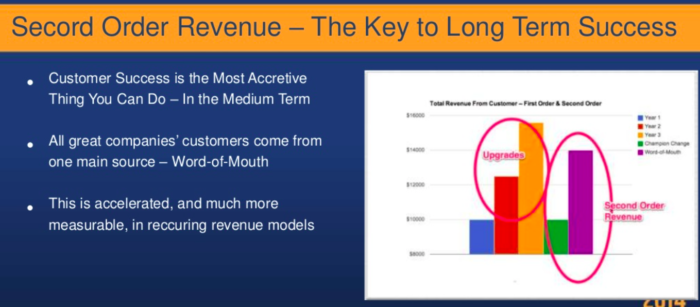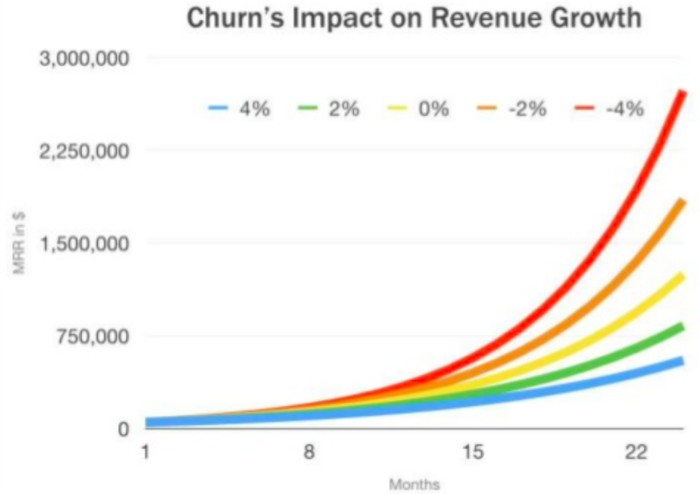A business cannot survive without loyal customers. SaaS companies depend on recurring customers. Ecommerce companies need to repeat purchase customers. Consumer internet companies need visitors to keep coming back on a routine basis. You get the point.
Happy customers are loyal customers. That’s why within many SaaS companies, there is a department for customer success. It’s more than a support team – their objective is to maintain happy customers, while also focusing on upsells and renewals.
Today’s post discusses the importance of investing in a customer success department.
The all-star lineup:
- Aaron Ross wrote the book Predictable Revenue, a must-read for those in SaaS.
- Jason Lemkin is a VC at Storm Ventures and runs SaaStr.
- Tomasz Tunguz is a partner at Redpoint Ventures and writes at tomtunguz.com.
- Brian Stafford is a partner at McKinsey.
Below is a summary outlining the customer success approach of each of these individuals.
Aaron Ross: Customer Success Is Not Glorified Support – it is a Growth Driver
Customer success is not an afterthought. It’s not something you put off until you’re big enough. That’s the wrong thinking. Customer success is an investment to start now.
Many companies in the B2B space believe that the more salespeople they hire, the more revenue they’ll receive. Salespeople don’t drive growth; lead generation drives growth. Salespeople help fulfill growth.
But not all leads are created equal. There are three types of leads:
- Seeds: One-to-many, these are leads from word of mouth. It’s largely done through customer success.
- Nets: One-to-many, these are leads from your marketing. This is typically from inbound marketing.
- Spears: One-to-one, these are leads from outbound prospecting.
Customer success is a growth driver. It is not glorified support. The executive team of the future should have a Head of Sales, Head of Marketing, and Head of Customer Success. These three roles should be of equal importance.
But there’s a problem – executives and entrepreneurs don’t want to make a big investment in customer success without first knowing how the department helps the company make money. The way to do this is to have customer success handle renewals and upsells.
Customer success isn’t responsible for just renewals and upsells. They also own the “90-day adoption”, which is time to value. They must show new customers the value of the product in 90 days. They also provide product roadmap feedback, because they are in close contact with customers and can provide valuable input for building something the customer wants.
Jason Lemkin: To Value Customer Success, Understand Upgrades and Second-Order Revenue
There are lots of tactics to grow a business, but the one thing that is guaranteed to work is successful, happy customers. You’ll acquire more customers if you make your current customers happy. All the big players in the internet space will tell you that they get 80% of their new customers from their old customers. The challenge is that it takes time.
The most important concept Lemkin found in his company (Echosign) was called second-order revenue. Sales are great at booking new customers, but that is only the tip of the iceberg. There are two things that occur.
The first is that successful customers on annual plans are more likely to renew for the 2nd, 3rd, and 4th year.
The second thing is upgrades – after a few years, the customer is likely to be paying more for your software than in their first year. Even more important is the true second-order revenue. This consists of two parts – customers of your product (the champions for your product) changing companies and bringing your product on board with the new company.
The other is word of mouth revenue. This system relies on customer success.
When you want to understand the value of customer success, you have to take into account all the revenue and second-order revenue they bring. It’s not just lifetime value and upgrades, it’s also the word of mouth and champion change.
Lemkin recommends hiring 1 customer success manager for every $2 million in annual revenue.
Taking this a step further, we know that upgrades and second-order revenue make customer success 5x more valuable than sales. That isn’t to say sales is useless, that would be nonsense. It means that sales is only the start of the relationship.
Customer success steps in after the sales process and ensures that customers stay around, upgrade, and refer others. When you see the revenue they bring after the initial sale, you’ll see just how important customer success really is.
Once you understand the value of customer success, book a plane ticket and visit your customers. The CEO should spend far more travel time visiting existing customers than closing deals. This is also a great way to ensure they remain loyal – Lemkin never lost a customer he visited.
Lemkin recommends having the customer success manager make it priority to visit 5 customers per month. This is in addition to the CEO doing their onsite visits.
Customer success is the best revenue center in a recurring revenue business. There’s no “best efforts” – it is not a soft science. You have to measure it, and then drive it up quarter after quarter. It shouldn’t be categorized under “cost of goods sold”. It should be with sales and marketing, because it is a cost of revenue.
Tomasz Tunguz: The Amount of Leverage You Can Get For a Tiny Investment is Stratospheric For the Business
There are three reasons why customer success is critical. The first is that you have happier customers because you’re listening to them, and because of that you end up building a better product.
The second is that happy customers = loyal customers who give word of mouth, and because of that you grow faster.
And the third is that you’ll grow at a more capital efficient rate because churn is lower.
This chart shows the impact of churn on revenue growth for a company growing at 15% per month. The bottom blue line shows what revenue growth is like at 4% churn. Look at where the orange and red lines are. That’s if you have zero or negative churn. This is why customer success is so important – happy customers are far less likely to cancel.
Brian Stafford: The Sooner You Invest in Customer Success, The Better
McKinsey ran an analysis looking at the biggest predictors of growth for $100 million companies that turned into $1 billion companies. They looked at 600 companies over a 15-year time period.
One predictor they found for companies going from $100 million – $1 billion was the ability to become good at something they weren’t previously good at. This means they had to build out a new channel or capability in order to grow to $1 billion.
Stafford hits on two customer success metrics – ARR growth per customer, and churn rate. He says that ARR growth is one of the most under-leveraged areas of growth for companies.
Roughly 80% of the companies in the McKinsey database are growing ARR per customer at less than 10% per year. There is a massive value driver in customer satisfaction translating to new ARR that has not been hit. Even with the companies that are growing ARR per customer 10%+ per year, nearly half their customers aren’t included. This is particularly true for bigger companies. There’s an offer to charge them more, and many companies haven’t taken advantage of that.
Churn gets a lot of lip service, but rarely the attention it deserves. The sooner you realize the importance of investing in customer success and therefore preventing churn, the better growth you’ll have.
Video & Slides
Q&A begins at about 35 minutes, 35 seconds.
About the Author: Zach Bulygo (Twitter) likes marketing, finance, and learning about different businesses.


Comments (2)